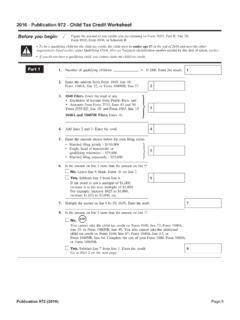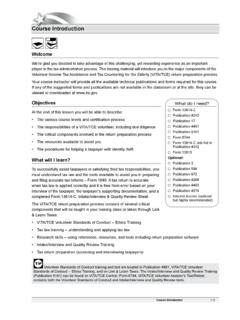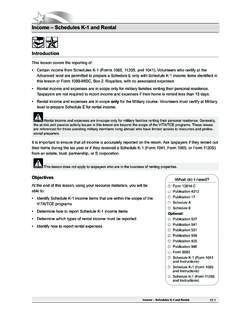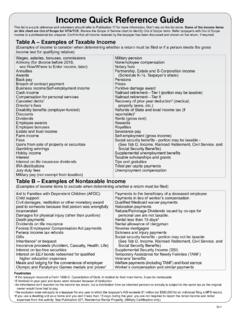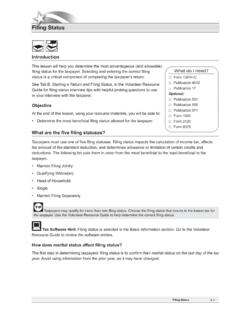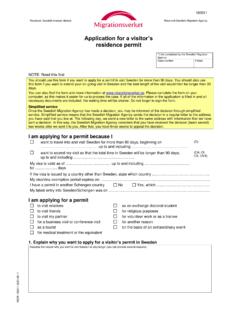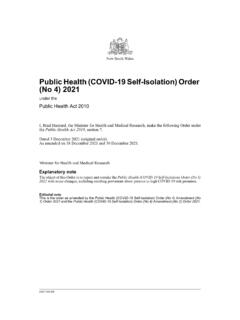Transcription of Adjustments to Basis in TaxSlayer - IRS tax forms
1 D-26 Adjustments to Basis in TaxSlayer Enter Capital Gain/Loss Transactions in TaxSlayerFor most transactions, you do not need to adjust the Basis . You may need to adjust the Basis if you received a form 1099-B or 1099-S (or substitute statement) that is incorrect, are excluding or postponing a capital gain, have a disallowed loss, or certain other situations. Details are in the table Scope from the dropdown listAdjustment Code that will appear on form 8949 You received a form 1099-B (or substitute statement) and the Basis shown in box 3 is the Basis was not reported to the IRS, report the correct Basis and make no adjustment. If the Basis was reported to the 1099-B with Basis in Box 3 is Incorrect & Correct Basis is Lower or HigherBYou received a form 1099-B or 1099-S (or substitute statement) and there are selling expenses that are not reflected on the form or the proceeds as reported in Box 1d.
2 Enter as an adjustment using a minus sign for any selling expenses that you paid (and that are not reflected on the form or statement you received). form 1099-B with Basis in Box 3 is Incorrect & Correct Basis is Lower or HigherEYou sold or exchanged your main home at a gain, must report the sale or exchange and can exclude some or all of the the sale or exchange as you would if were not taking the exclusion. Then enter the amount of excluded (nontaxable) gain as a negative Some/All of the Gain from the Sale of Your Main HomeHYou have a nondeductible loss other than a loss indicated by code the sale or exchange and enter the amount of the nondeductible loss as an adjustment. See Nondeductible Losses in the Instructions for Schedule loss other than a Wash Sale*See Tab R, Glossary and Index, for thedefinition of wash report multiple transactions on a single row as described in Exception to Reporting each Transaction on a Separate -0- as the adjustment amount unless an adjustment is required because of another Multiple Transactions on a Single RowMYou received a form 1099-B (or substitute statement) and the type of gain or loss (short term or long term) shown in box 1c is incorrect).
3 Enter transaction with correct term (long or short). Enter -0- as the adjustment amount unless an adjustment is required because of another 1099-B and Type of Gain/Loss indicated in Box 2 is incorrectTYou have a nondeductible loss from a wash sale* ..Report the sale or exchange and enter the amount of the nondeductible loss as an loss from a Wash Sale*WYou have an adjustment not explained earlier in this the appropriateadjustment adjustmentOD-27 Adjustments to Basis in TaxSlayer (continued) Out of Scope CodeYou received a form 1099-B or 1099-S (or substitute statement) as a nominee for the actual owner of the sold or exchanged qualified small business stock and can exclude part of the can exclude all or part of your gain under the rules explained in the Schedule D instructions for DC Zone assets or qualified community are electing to postpone all or part of your gain under the rules explained in the Schedule D instructions for any rollover of gain (for example, rollover of gain from QSB stock or publicly traded securities).
4 RYou had a loss from the sale, exchange, or worthlessness of small business (section 1244) stock and the total loss is more than the maximum amount that can be treated as an ordinary disposed of collectibles (see the Schedule D instructions).C* Wash sales are in scope only if reported on form 1099-B or on a brokerage or mutual fund Gains or Losses Sale of Main HomeThe sale or exchange of a main home must be reported as a Capital Gain or Loss if: The taxpayer can t exclude all of their gain from income, The taxpayer has a gain and chooses not to exclude it, or The taxpayer received a form 1099-S for the sale or : The taxpayer does not have to report the sale of their main home if they qualify and choose to exclude all of their gain and did not receive form 1099-S. See Tab R, Glossary and Index, for a definition of main , if the following two tests below are met, the taxpayer can exclude up to $250,000 of gain.
5 If both the taxpayer and their spouse meet these tests and file a joint return, they can exclude up to $500,000 of gain (but only one spouse needs to meet the ownership requirement in Test 1). Reduced exclusions are Out of Scope. Test 1. During the 5-year period ending on the date the taxpayer sold or exchanged their home, they owned it for 2 years or more (the ownership requirement) and lived in it as their main home for 2 years or more (the use requirement).Note: Military members may be able to suspend the 5-year period while serving on qualified official extended duty. Test 2. The taxpayer hasn t excluded gain on the sale or exchange of another main home during the 2-year period ending on the date of the sale or exchange of their the taxpayer has a gain that can t be excluded, it is taxable. Note: Sale of a home received through inheritance or as a gift is Out of Scope unless it has been used as a personal residence by the taxpayer or spouse.
6 The taxpayer must provide the cost Basis of the residence . Tests 1 and 2 then apply to exclude the of spouse. If the taxpayer sells their home within 2 years after their spouse dies and has not remarried as of the sale date, they can count any time their spouse owned the home as time they owned it and any time when the home was their spouse s residence as time when it was their residence . In addition, the taxpayer may be able to increase their ex-clusion amount from $250,000 to $500,000 if the taxpayer or their deceased spouse meet the requirements for Test 1 and both the taxpayer and their deceased spouse meet the requirement for Test the taxpayer is required to report the sale and it results in a gain, enter the purchase date, sale date, purchase price, and sales price in the Sale of Home Worksheet (you will enter capital improvements and other Adjustments to Basis on the next screen).
7 Out of scopeOut of scopeD-29 Capital Gains or Losses Sale of Main Home (continued)Enter the number of days the dwelling was used as the main home (separate entry for spouse). Enter the number of days the taxpayer owned the home (separate entry for spouse).If the taxpayer meets the ownership, residence , and look-back requirements, taking the exceptions into account, then the Eligibility Test is met and the taxpayer is eligible for the Maximum Exclusion, select the box (reduced maximum exclusion is Out of Scope; refer to a professional).If the taxpayer received the 2008 First-Time Homebuyers Credit, select the box. form 5405, Repayment of the First-Time Homebuyer Credit, will be required to determine how much of the credit must be repaid. The HUD-1 Settlement Statement will give details about closing costs. If the sale must be reported and results in a gain, it will be listed on the appropriate form 8949 ( Basis type C or F).
8 The gain will be included with the other capital gains and losses on Schedule D. Enter the fees from the purchase of the home that weren t included in the purchase price already Gains or Losses Sale of Main Home (continued) Enter the selling expenses, cost of improvements and other increases or decreases to the Basis of the home. See Publication 523, Selling Your Home, for more information about Basis . This will calculate the adjusted Basis of the home, which will be shown on form 8949. The information will carry to form 8949 and Schedule D. If you ve checked the box to exclude the entire gain, form 8949 will show the adjustment as a negative number in the amount of the net gain, with adjustment code H and Basis type F and no net the sale resulted in a gain but was not eligible for the exclusion, it will be reported on the appropriate form 8949 as a : The taxpayer received a form 1099-S for the sale of their main home.
9 The taxpayer s adjusted Basis in the home is $150,000. The proceeds from the sale is $200,000. The taxpayer meets the ownership and use tests. The tax-payer s form 8949 is shown Gains or Losses Sale of Main Home (continued)If the sale is a loss but must be reported because form 1099-S was received:Loss on the sale of a main home can t be deducted. To report the sale, you must enter the sale as a capital gain or loss item: You can use the Sale of Main Home worksheet to assist you in determining the Basis , but the information will NOT carry to form 8949 Add a new Capital Gain or Loss Item Enter the dates, sales price and adjusted Basis amount The Basis type will be Did not receive form 1099-B Enter an adjustment in the amount of the loss as a positive numberSelect the adjustment reason as nondeductible loss other than a wash sale which will show as adjustment code L.
